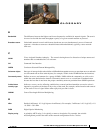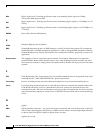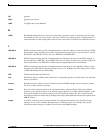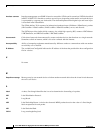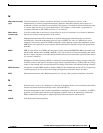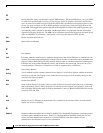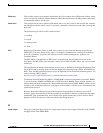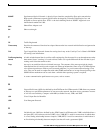
Glossary
GL-3
Cisco ASR 1000 Series Aggregation Services Routers MIB Specifications Guide
OL-15161-06
GB
gigabyte
GBps
gigabytes per second
10GE
10 Gigabit per second Ethernet
H
HSRP
Hot Standby Routing Protocol. Protocol used among a group of routers for selecting an active router
and a standby router. (An active router is the router of choice for routing packets; a standby router is a
router that takes over the routing duties when an active router fails, or when preset conditions are met.)
I
IEEE 802.2
IEEE LAN protocol that specifies an implementation of the LLC sublayer of the data link layer. IEEE
802.2 handles errors, framing, flow control, and the network layer (Layer 3) service interface. Used in
IEEE 802.3 and IEEE 802.5 LANs. See also IEEE 802.3 and IEEE 802.5.
IEEE 802.3
IEEE LAN protocol that specifies an implementation of the physical layer and the MAC sublayer of
the data link layer. IEEE 802.3 uses CSMA/CD access at a variety of speeds over a variety of physical
media. Extensions to the IEEE 802.3 standard specify implementations for Fast Ethernet.
IEEE 802.5
IEEE LAN protocol that specifies an implementation of the physical layer and MAC sublayer of the
data link layer. IEEE 802.5 uses token passing access at 4 or 16 Mbps over STP cabling and is similar
to IBM Token Ring. See also Token Ring.
IETF
The Internet Engineering Task Force
Info
Notification about a condition that could lead to an impending problem or notification of an event that
improves operation.
Informs
Reliable messages, which are stored in memory until the SNMP manager issues a response. Informs
use more system resources than traps.
ifIndex
Each row of the interfaces table has an associated number, called an ifIndex. You use the ifIndex
number to get a specific instance of an interfaces group object. For example, ifInNUcastPkts.1 would
find you the number of broadcast packets received on interface number one. You can then find the
description of interface number one by looking at the object which holds the interface description (from
MIB-II) ifDescr.
Integer
A numeric value that can be an actual number. For example, the number of lost IP packets on an
interface. It also can be a number that represents a nonnumeric value. For example, the variable
tsLineType returns the type of terminal services line to the SNMP manager.



